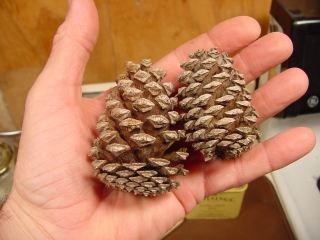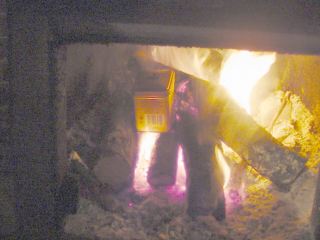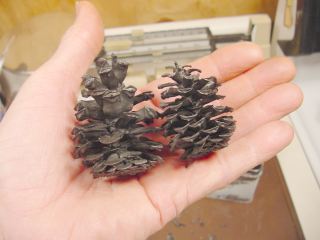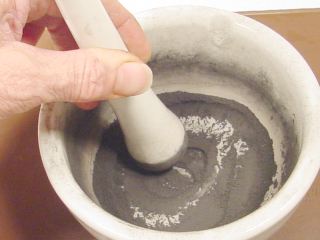

Note that this instruction is for making powder
to be used in rocket ignition and parachute ejection.
It is not intended for use in firearms or as an explosive.
If that is your intent, please do not read any further, as this powder
is not particularly good for those purposes.
Here we are going to make a rather poor grade of black powder. But "poor" is a relative term. For black powder, "good" normally refers to its use in firearms, where fast-burning and clean-burning are highly desired qualities.
For rocket ignition, neither of those qualities is particularly desirable. Quick burning may create dangerous pressures which could crack a sugar grain or cause other mayhem. A "dirty" burn creates droplets of molten KNO3 slag which spatters the grain with oxidizing hot spots and thus facilitates ignition.
For ejection, a really fast burn creates more of a shock rather than the gentle push which is desired to get the parachute out of the airframe.
Ingredients:
Potassium Nitrate (KNO3)
Charcoal
Sulfur ("flour" sulfur, not "flowers of sulfur")
Dextrin (optional)
Potassium Nitrate (a.k.a. KNO3, saltpeter)
Potassium nitrate should be a good grade, either technical, pharmaceutical,
or food-grade. That said, I have obtained good results lately with
some fertilizer-grade KNO3 from Atlantis Hydroponics.
It must be finely ground.
Even if you receive it as a superfine mesh, some grinding or sifting may
be required to get the lumps out.
Charcoal
Barbecue charcoal just doesn't cut it. Don't waste your time. It contains other things besides charcoal which do not make for even mediocre black powder. Sand, for instance.
Pyrotechnic-grade charcoal can be purchased from a number of suppliers. It is cheap, so if you are ordering from Skylighter or FireFox, go ahead and get a pound or two. If all you are doing is making ignitors and ejection powder, that should last a lifetime.
But don't make an order just for charcoal, it is easy to make and kinda fun.
Here is how:
Get some wood. Shavings are good, sawdust OK. Larger chunks can be used but will take longer to cook and be harder to grind up. The wood should be clean, with no sand, paint, old nails... nothing but wood. Oh, and no pressure-treated wood either. It can be hardwood or softwood, although the black powder "pros" tend to recommend willow wood.
I use pine cones. Perhaps not optimal by professional standards, but they come in convenient sizes, are rather attractive, and are very cost-effective.
The one warning on wood for charcoal is to avoid using nut hulls, as the resulting charcoal is rumored to cause spontaneous ignition.
The woody stuff is placed in a metal can with a tight-fitting lid. One small hole is punched in the lid to allow gasses to escape.


The can is placed in a hot spot. Since my wood stove is burning tonight, I will just toss the can in and leave it awhile. Elegant. But any substantial heat source will do. I first made charcoal in Mom's kitchen on an electric stove burner. Boy, did the house stink after that! This process generates a LOT of smoke! Outdoors is recommended. A Coleman stove is good. A campfire works fine. Even an electric hotplate running from a drop cord should do OK.
After the smoking stops, remove the can, let it cool, and open it up.


The results of this treatment are charcoal pine cones! They are beautiful in a way, and break with a sharp tinkle. The wood is porous, making grinding them to a powder fairly easy. For a more efficient grinding method, Click Here.

If you can see the particles, it is not ground up enough. Keep
going. For ignition/ejection powder, mortar and pestle grinding should
be adequate. But if you want to remove any chunks, consider sifting
this through pantyhose. Be sure to get the permission of the hose
owner first! Forgiveness may not come easy.
Sulfur
For added confusion, sulfur tends to come in two very different forms with similar names. "Flour sulfur" is mined from deep in the earth by injecting high-pressure steam into sulfur-rich strata, then sucking up the melted sulfur which is powdered and sold with no further modification.
"Flowers of sulfur" as found in the pharmacy, is also known as "sublimed
sulfur." It is a crystalline form made by heating sulfur, and condensing
the vapor thus generated. It is rumored to cause spontaneous ignition,
thus should not be used in making black powder. Flour sulfur is much
cheaper anyway.
Dextrin
Is the stuff used to make postage stamps and envelopes stick - the lick'em kind, not peel-and-stick. It is a food product which turns out to be a pretty good glue. Some health-food stores carry it, as it is considered a "good" thing to have in the diet. Perhaps it helps folks stay thin by sticking their insides together.
It is not necessary to put dextrin in black powder, but it helps the grains hold together. This is especially useful if you intend to make dipped-head electric ignitors or black match, as it will help to keep the black powder in place. It also serves as an auxiliary fuel, so the charcoal and sulfur can be reduced a bit, if you like.
Yellow dextrin is preferred, but I have used white dextrin and it works
OK.
The procedure
Weigh out:
7.5 grams of potassium nitrate
1.5 grams charcoal
1.0 gram sulfur
0.5 gram dextrin (or leave it out)
Sift through a tea-strainer to get the lumps out. Mix gently, and add water, a little at a time, until the powder is completely moistened but only just so. The difference between "enough water" and "too much water!" is just a drop.
When it is the consistency of a dough, mix it a lot. More is better. Commercial powder mills used to have huge stone wheels that rolled over the wet mixture for many hours to get it well-incorporated. We do not need that level of quality, but a few minutes of mixing are very beneficial.
Turn the black dough out onto a flat pan, preferably glass, stainless steel, or ceramic. Press it flat, to speed up the drying process. Place the pan in a protected warm dry spot, but not a hot spot. Heat will cause the KNO3 to migrate out of the mixture and deposit itself elsewhere on the drying pan. While this is not a killer (remember that we want to make mediocre powder) it is not desirable either.
Once the "powder" is completely dry, use a wooden or plastic spatula to scrape it off the pan. It will be chunky. Put on your gloves and face shield, dump it back in the mortar, and pestle it until it is a powder again.
Store this powder in a plastic container such as a film-can or medicine vial. DO NOT store it in a glass container. If it should somehow ignite, the flying glass shards will be much more dangerous than the explosion itself.
So now you have made some black powder. I consider this to be one of humanity's finest achievements, and encourage you to become familiar with it. In small quantities. May your burns be minor and your injuries trivial. The dragon bites: keep him little.